When I was young, my mother used to cook every meal at home, and we seldom ate out. On one rare occasion, she decided not to cook and asked me to purchase noodles at the restaurant just five minutes from where we lived.
That was my first experience eating Yi Mein. My mom used to cook basic food as she couldn’t eat any spicy food. As such, the flavor of Yi Mein blew my mind, as it was a stark contrast to what I was used to at home.
I was immediately hooked on the flavor of Yi Mein, and I have been having it regularly since then.
Note: This post may contain affiliate links. Please read my privacy policy for more info. I may receive commissions for purchases made through links in this post. As an Amazon Associate, I earn from qualifying purchases.
🆚 The difference between Yi Mein vs. other noodles
Fast forward to my adulthood. As I ventured into the food business over the past 20 years, I have been exposed to various styles of noodle cooking. However, Yi Mein still holds a special place in my heart due to its unique texture and flavor.
The secret to its deliciousness is that it is deep-fried Cantonese egg noodles. This means that when you purchase it, this golden yellow color noodle is already cooked, but since it is deep-fried and dry, it can be stored for a long time without losing its flavor. The deep-frying process adds flavor to the noodles, making them distinctly different.
The process also involves adding lye water (kansui/枧水), making the noodles springy.
Note: There are a few English translations of this noodle: Yee Mein, Yi Mein, yī miàn, and Yee Mee are all the same.
🛒Ingredients needed for Yi Mein recipe

- Noodles. The most important ingredient is, of course, the noodles. I live in Malaysia, and the noodles always come in a large disc shape. They are egg noodles that have already been deep-fried and can be eaten without further cooking. The noodles have a distinguished flavor due to deep frying and a springy texture. It is available in most Asian grocery stores.
- Meat and shrimp are the most common ingredients used in Malaysia to prepare braised Yi Mein. You can substitute pork with chicken breast meat if you do not eat pork. The meat should be marinated to provide more flavor, and the shrimp should be soaked in baking soda and salt to make it crunchy.
- Fish cake is widely used in Malaysia to cook noodles. If unavailable, you can omit or substitute it with other seafood, such as squid or fish balls.
- Mushrooms. Another commonly used ingredient in this Yi Mein recipe is mushrooms. It is particularly popular in the Hong Kong style Yi Mein recipe, in which the noodles are not braised but just stir-fried directly. However, I will exclude it because I prefer to make this Malaysian Chinese recipe as authentic as possible.
- Vegetables. As for vegetables, I choose choy sum or gai lan (Chinese broccoli). Bok choy is also suitable. Another popular ingredient is Chinese chive, which I substitute with green onions in this recipe. Green onions are more popular in Malaysia, but Chinese chives (韭黄) are more popular for preparing Hong Kong-style fried Yi Mein.
- Stock. Lastly, using stock to prepare these braised noodles is always better than just water. I used chicken broth today, and another commonly used option is anchovy stock.
👉 Yi Mein recipe – the step-by-step instruction
1. Slice the chicken breast into thin pieces and marinate with light soy sauce, salt, and sesame oil for at least 15 minutes.
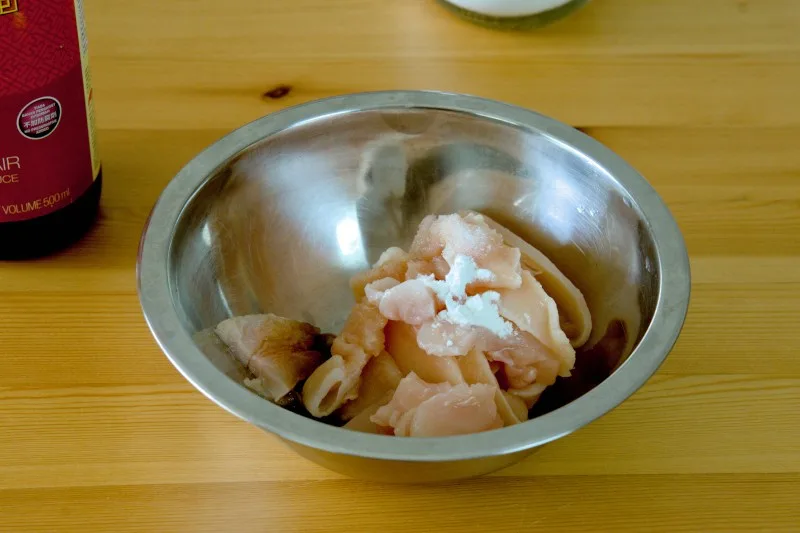
2. Remove the shrimp’s heads and shells, devein them, and soak them in a mixture of baking soda, salt, and water for 10 minutes. Rinse thoroughly and set aside.
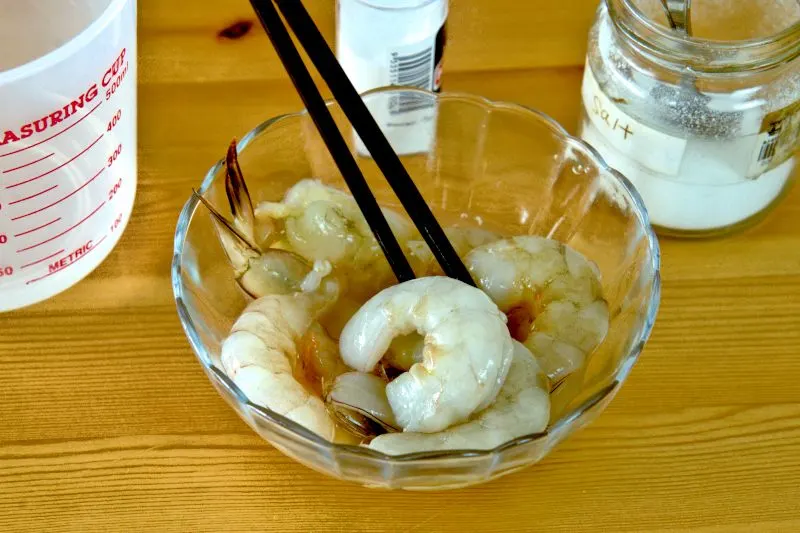
3. Wash the choy sum and cut it into short sections. Cut the green onions and carrots into short strips.
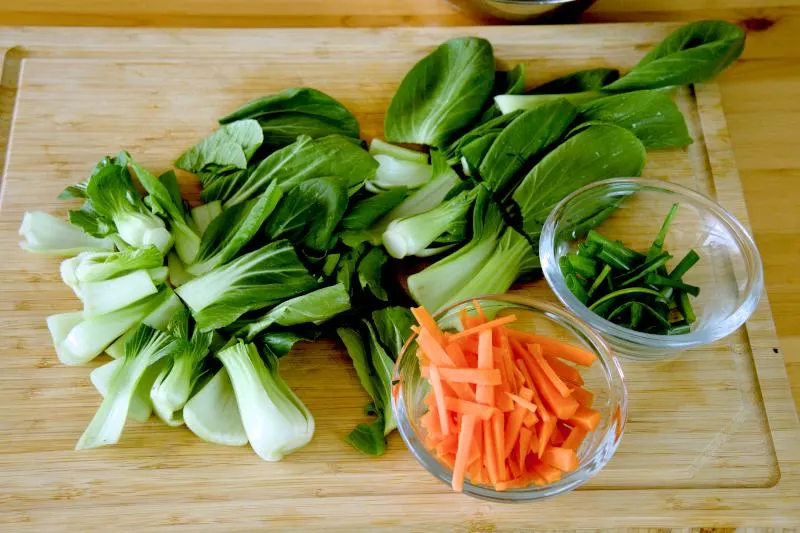
4. Heat two tablespoons of vegetable oil in a wok or pan. Add the chicken slices and stir-fry for about 20 seconds over low to medium heat. Then, add a tablespoon of chopped garlic. Continue stir-frying until the chicken changes color, then add the shrimp.
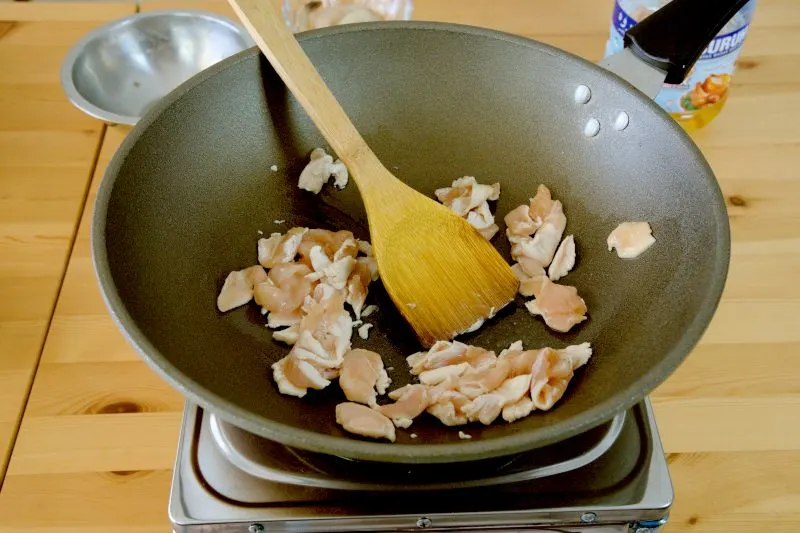
5. Continue stir-frying the chicken and shrimp until the shrimp is slightly charred and fragrant. Remove and set aside.
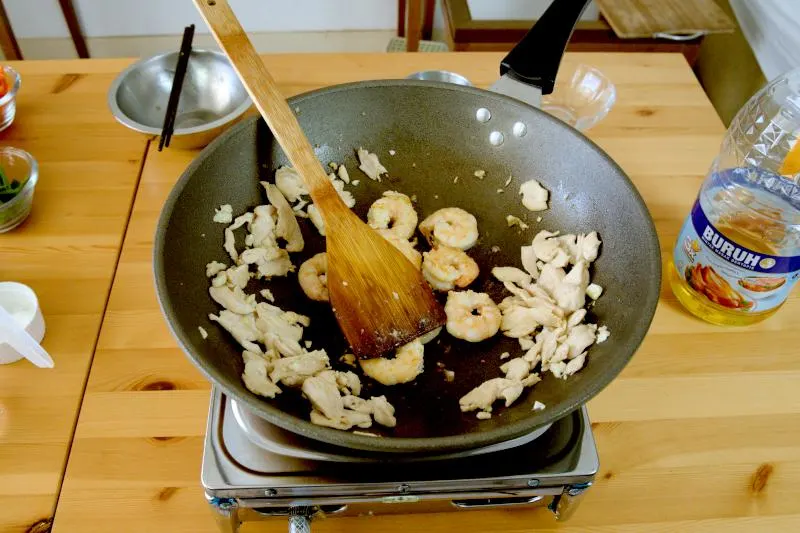
6. Add more oil to the pan and stir-fry the choy sum over medium to high heat. When the vegetables start to wilt, add chicken broth or water and bring to a boil. Season with light soy sauce, oyster sauce, salt, white pepper, and Shaoxing wine.
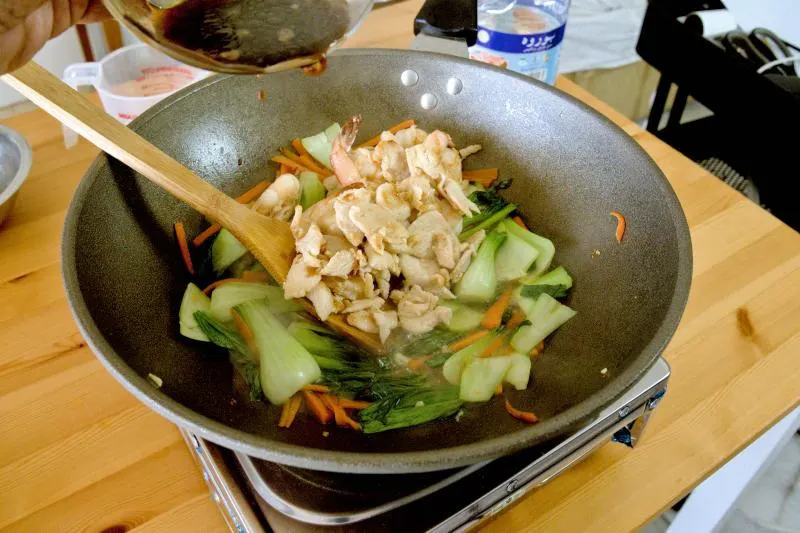
7. Thicken the sauce with cornstarch slurry. Return the chicken and shrimp to the pan and mix well.
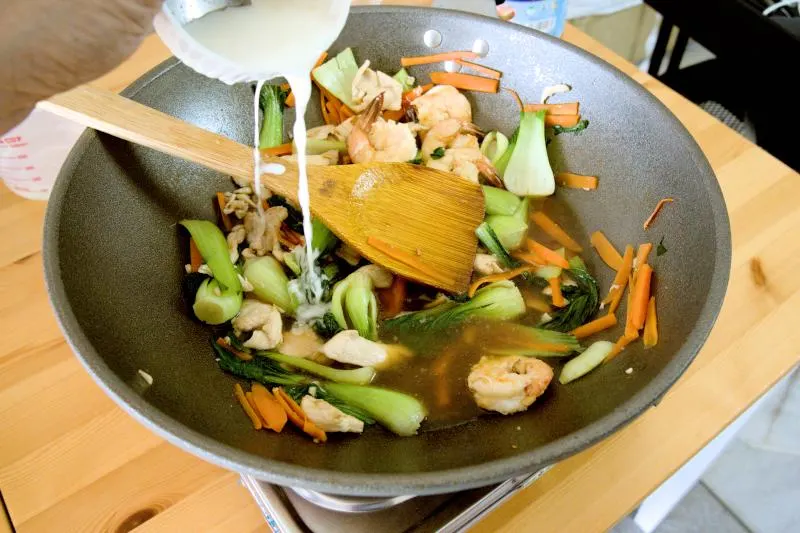
8. There are two serving options: (a) Place the noodles on a plate and pour the gravy on top to serve. (b) Boil a pot of water, and add the noodles to blanch for about 30 seconds. Drain, return the drained noodles to the wok, and mix with other ingredients before serving. Please refer to the note section below for details on the differences between these two methods.
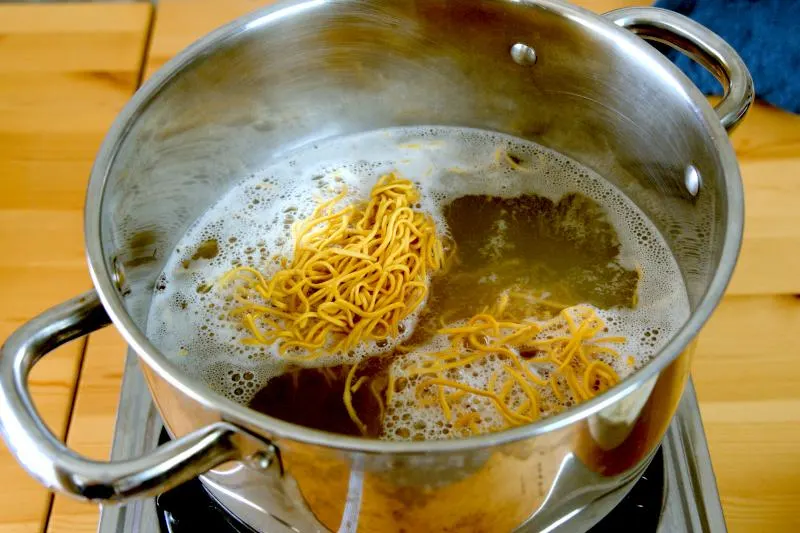
💡Tips to make the best Yi Mein
- Please do not substitute Yi Mein with other noodles in this recipe. Even though the ingredients are the same, the flavor will differ if you use other noodles.
- To make the shrimp crunchy, soak them in a concentrated solution containing baking soda (sodium bicarbonate) and salt for ten minutes, then wash them thoroughly. Chinese chefs use this technique to make the texture of the shrimp crunchy.
- While stir-frying the shrimp, be careful not to overcook them. If you prefer barely cooked shrimp, stir-fry them lightly.
- You can choose not to stir-fry the vegetables. If you skip this step, add the vegetables only after the chicken broth or water boils. However, I prefer to stir-fry the vegetables as it enhances the flavor.
- I use basic Cantonese seasonings. I don’t use dark soy sauce because I prefer a lighter color, but you can add a little.
- When serving the noodles, you can pour the gravy and ingredients on top of the noodles on a serving plate. This makes the noodle dish look more presentable, and the noodles will be more crunchy. Alternatively, if you prefer softer noodles, you can blanch them for half a minute before mixing them with other ingredients. The texture of the noodles will become softer in this case.
🍽️ Variation: Stir-fry the noodles.
Another popular cooking method to prepare Yi Mein is to stir-fry it with vegetables, meat, and shiitake mushrooms. Yi Mein is also known as longevity noodles or long life noodles because the long noodles symbolize longevity and good luck, and it is often served at birthday celebrations. This dish is particularly popular in Hong Kong to serve during Chinese banquets and Chinese New Year
🗄️ How to store the leftovers of this noodle?
I would suggest not keeping any leftovers for Yi Mein. The noodles absorb water and gravy, causing them to become soft and lose their chewy texture, even if stored in an airtight container in the refrigerator. The longer you keep it, the softer and soggier it becomes. Therefore, it’s best to consume any leftovers on the same day.
📖 Other related Chinese noodles
If you like this Yi Mein recipe, I would love to share more Chinese noodle recipes.
- Ipoh shredded chicken noodles (怡保河粉)
- Taiwanese Beef Noodle Soup (红烧牛肉面)
- Mee Hailam – Malaysian noodles with Hainanese influence
🔎The origin of Yi Mein
According to this source, E-fu noodles, also known as Yi Mein, 伊府面, were invented by Yi Bingshou 伊秉绶 (1754—1815), a Qing Dynasty poet and calligrapher who once served as the governor of Huizhou 惠州. Yi Bingshou asked his cook to beat eggs into wheat flour and mix them with water. Then, the noodles were dried in the sun, fried until golden, and stored for later use.
After tasting the dish, the poet and calligrapher Song Xiang 宋湘 was amazed by the taste and said, “Such a delicacy has no good name, which is a bit unfair.” From then on, the name of the noodles was called e-fu-mein, which means the Yi family’s noodles, and gradually became popular among the people, abbreviated as “Yi Mein.”
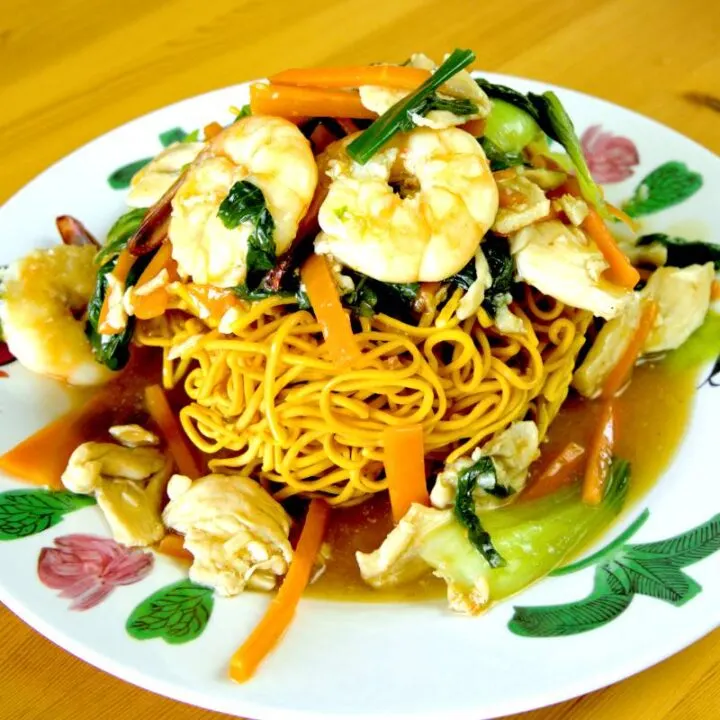
Yi Mein (yee mee / 伊面) - Cantonese noodles recipe
This is a Yi Mein (yee mee / 伊面) recipe that is popular among the Chinese in Malaysia. Very flavorful, the deep-fried Yi Mein has a totally different dimension of flavor than other noodles.
Ingredients
- 1Ingredients A
- 300g Yi Mein
- 170g chicken bread meat, sliced thinly
- 6 medium-sized shrimp, clean, devein, and leave the tail on
- 1 tbsp chopped garlic
- 1 stalks of green onion, cut into one-inch sections
- 1 small carrot, cut into one-inch long strips
- 150g choy sum, cut into two-inch sections
Ingredients B
- 2 tbsp light soy sauce
- 1 tbsp oyster sauce
- 2 tsp sesame oil
- 1/4 tsp white pepper
- 1 tbsp Shaoxing wine (optional)
- 1 tbsp cornstarch (plus 3 tbsp of cold water to form a slurry)
- 1/2 tsp salt
- 1/4 tsp ground white pepper
- 1 cup chicken stock
- 1 cup water
Instructions
1. Slice the chicken breast into thin pieces and marinate with soy sauce, salt, and sesame oil for at least 15 minutes.
2. Remove the shrimp's heads and shells, devein them, and soak them in a mixture of baking soda, salt, and water for 10 minutes. Rinse thoroughly and set aside.
3. Cut the choy sum into short sections, green onions and carrots into short strips.
4. In a wok or pan, heat two tablespoons of vegetable oil. Add the chicken slices and stir-fry for about 20 seconds over low to medium heat. Then add a tablespoon of chopped garlic.
5. Continue stir-frying until the chicken changes color, then add the shrimp.
6. Continue stir-frying the chicken and shrimp until the shrimp is cooked. Remove and set aside.
7. Stir-fry the choy sum over medium to high heat. When the vegetables start to wilt, add chicken broth or water and bring to a boil. Season with light soy sauce, oyster sauce, salt, white pepper, and Shaoxing wine, salt and pepper.
8. Thicken the sauce with cornstarch slurry. mix well.
9. There are two serving options:
A. Place the noodles on a serving plate and pour the gravy over them.
B. Boil a pot of water, add the dry noodles for about 30 seconds, drain, then return the drained noodles to the wok and mix with other ingredients before serving.
Recommended Products
As an Amazon Associate and member of other affiliate programs, I earn from qualifying purchases.
-
 TBWHL Skimmer Slotted Spoon, Heavy Duty 304 Stainless Steel Slotted Spoon with Vacuum Ergonomic Handle, Comfortable Grip Design Strainer Ladle for Kitchen, 14.96 Inches
TBWHL Skimmer Slotted Spoon, Heavy Duty 304 Stainless Steel Slotted Spoon with Vacuum Ergonomic Handle, Comfortable Grip Design Strainer Ladle for Kitchen, 14.96 Inches -
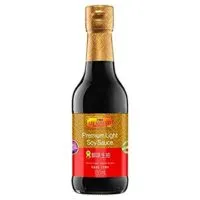 Lee Kum Kee Premium Light Soy Sauce - 150ml (5.27 fl oz)
Lee Kum Kee Premium Light Soy Sauce - 150ml (5.27 fl oz) -
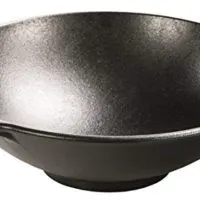 Lodge 14 Inch Cast Iron Wok. Pre-Seasoned Wok with Flattened Bottom for Asian Stir Fry and Sautees
Lodge 14 Inch Cast Iron Wok. Pre-Seasoned Wok with Flattened Bottom for Asian Stir Fry and Sautees
Nutrition Information:
Yield: 2 Serving Size: 1Amount Per Serving: Calories: 516Total Fat: 25gSaturated Fat: 7gTrans Fat: 0gUnsaturated Fat: 16gCholesterol: 167mgSodium: 2447mgCarbohydrates: 23gFiber: 2gSugar: 4gProtein: 47g
This data was provided and calculated by Nutritionix on 23/9/2022

How to Make Perfect Chinese Glass Noodle Stir-fry
Friday 30th of May 2025
[…] Yi Mein (yee mee / 伊面) – Cantonese noodles recipe […]
yanna
Friday 7th of February 2025
I always prefer to have tauge (bean sprouts) in my noodles. I'll put tauge whenever I cook any type of noodles.
Yi Mein (yee mee / 伊面) – Cantonese noodles recipe - culinaryadventure.online
Sunday 6th of October 2024
[…] Provide hyperlink […]
KP Kwan
Tuesday 24th of September 2024
Hi, this is KP Kwan. I am happy to see you in this comment area, as you have read through my recipe. I am glad to reply to any questions and comments as soon as possible.
vito
Wednesday 25th of September 2024
@KP Kwan, hi, i'm a little surprised that there is no garlic and ginger in recipe. good idea to add them or not? if yes what amounts? ty. vito